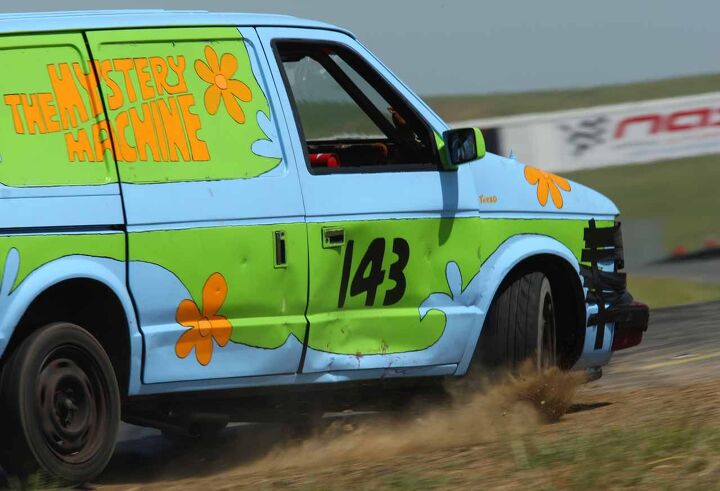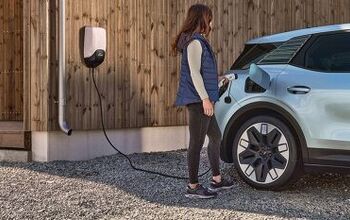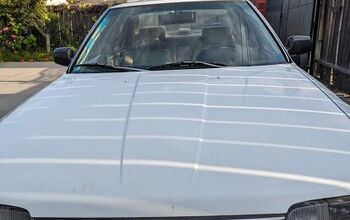Junkyard Find: 1977 Dodge Tradesman 200 Mystery Machine

The Chrysler Corporation sold vans based on the B-Series platform from the 1971 through 2003 model years, giving them Dodge, Plymouth and Fargo badging along the way. Today's Junkyard Find is a first-generation B-van, found in a Colorado boneyard.
The Mystery Machine from the "Scooby-Doo" animated series has inspired countless van owners to slather on various blue/green/yellow/whatever paint schemes over the decades, and that's what happened to this Tradesman.
I was three years old when the "Scooby Doo, Where Are You!" series launched, but I managed to avoid it for my entire Generation X childhood (though I was heavily influenced by Simon Bar Sinister's brain-reprogramming Phoney Booths in "Underdog" at that time).
Working as a wise and respected judge for the 24 Hours of Lemons Supreme Court since 2008, I've seen plenty of Mystery Machine-themed race cars, including some genuine vans.
You can get away with a Mystery Machine race wagon, too, as long as the team's costumes measure up.
A Sentra Mystery Machine? Why not?
Subaru Mystery Machine? Sure!
You get the idea. And yet with all the Mystery Machines I've seen on race tracks and at car shows, today's '77 Tradesman is the first Mystery Machine I've documented in a junkyard.
Maybe they just don't get thrown away, unlike Kidnapper Vans (this one got discarded in a Northern California yard back in 2007 or so).
This Tradesman got a mild camper conversion at some point.
It has wood paneling, mismatched junkyard-obtained captain's chairs and break-in-proof rear windows.
For the 1971 through 1980 model years, the passenger versions of these vans were given Sportsman badging, while the cargo versions were Tradesmen. The Tradesmen were preferred for customizing, because the windowless side sheet metal provided more space for airbrush murals and bubble windows shaped like hearts or pot leaves.
For 1981, the passenger B-Series vans became Ram Wagons and the cargo versions became Ram Vans.
Production continued through 2003, though major revisions took place in 1998 and body components from those vans won't swap with the 1971-1997 vans (underneath the skin, the chassis remained more or less unchanged).
Ford and GM stuck with their B-Series competitors for similar spans. Ford's E-Series (best known as the Econoline) stayed about the same from the 1975 through 1991 model years, then lived on a version of the original chassis through 2014. General Motors built the G-Series Sportvan/ Rally/ Chevy Van/ Vandura in essentially the same form from 1971 through 1996.
The build tag says it was built at St. Louis Assembly, and that its first engine was a 318-cubic-inch V8 with one-barrel carburetor.
This is a Chrysler LA small-block for sure, and that's a Carter BBD one-barrel carburetor, so it could be the original engine.
Instead of the base three-speed column-shift manual, this van has the optional three-speed automatic. Such luxury! Chrysler went to four-on-the-floor rigs for their three-pedal B-vans a few years later, with the shifter mounted where the driver had to reach back for it.
It's rusty in the usual spots, and there's not much demand for Malaise Era Mystery Machines with 150-horsepower smog V8s. Next stop: The Crusher!
1977 Dodge Tradesman 200 in Colorado junkyard.
1977 Dodge Tradesman 200 in Colorado junkyard.
1977 Dodge Tradesman 200 in Colorado junkyard.
1977 Dodge Tradesman 200 in Colorado junkyard.
1977 Dodge Tradesman 200 in Colorado junkyard.
1977 Dodge Tradesman 200 in Colorado junkyard.
1977 Dodge Tradesman 200 in Colorado junkyard.
1977 Dodge Tradesman 200 in Colorado junkyard.
1977 Dodge Tradesman 200 in Colorado junkyard.
1977 Dodge Tradesman 200 in Colorado junkyard.
1977 Dodge Tradesman 200 in Colorado junkyard.
1977 Dodge Tradesman 200 in Colorado junkyard.
1977 Dodge Tradesman 200 in Colorado junkyard.
1977 Dodge Tradesman 200 in Colorado junkyard.
1977 Dodge Tradesman 200 in Colorado junkyard.
1977 Dodge Tradesman 200 in Colorado junkyard.
1977 Dodge Tradesman 200 in Colorado junkyard.
[Images: The Author]
Become a TTAC insider. Get the latest news, features, TTAC takes, and everything else that gets to the truth about cars first by subscribing to our newsletter.

Murilee Martin is the pen name of Phil Greden, a writer who has lived in Minnesota, California, Georgia and (now) Colorado. He has toiled at copywriting, technical writing, junkmail writing, fiction writing and now automotive writing. He has owned many terrible vehicles and some good ones. He spends a great deal of time in self-service junkyards. These days, he writes for publications including Autoweek, Autoblog, Hagerty, The Truth About Cars and Capital One.
More by Murilee Martin
Latest Car Reviews
Read moreLatest Product Reviews
Read moreRecent Comments
- Varezhka Any plans yet for Stellantis to wind down some of their dozen plus brands? I mean, most of their European brands (except Fiat and Maserati) are not only 80~90% European sales but also becoming old GM level badge jobs of each other. Lots of almost identical cars fighting within the same small continent. Shouldn't they at least go the Opel/Vauxhall route of one country, one brand to avoid cannibalization? The American brands, at least, have already consolidated with Dodge/Chrysler/Jeep/RAM essentially operating like a single brand. An Auto Union of a sort.
- Namesakeone I read somewhere that Mazda, before the Volkswagen diesel scandal and despite presumably tearing apart and examining several Golfs and Jettas, couldn't figure out how VW did it and decided then not to offer a diesel. Later, when Dieselgate surfaced, it was hinted that Mazda did discover what Volkswagen was doing and kept quiet about it. Maybe Mazda realizes that they don't have the resources of Toyota and cannot do it as well, so they will concentrate on what they do well. Maybe Mazda will decide that they can do well with the RWD midsized sedan with the inline six they were considering a few years ago
- IH_Fever A little math: An average, not super high end EV (like a model 3) has 70 kwh of storage assuming perfect fully charged conditions. An average 2-3 person home uses roughly 30 kwh per day. So in theory you have a little over 2 days of juice. Real world, less than that. This could be great if your normal outage is short and you're already spending $50k on a car. I'll stick with my $500 generator and $200 in gas that just got me through a week of no power. A/c, fridge, tv, lights, we were living large. :)
- EBFlex No. The major apprehension to buying EVs is already well known. The entire premise of the bird cage liner NYT is ridiculous.The better solution to power your house when the power goes out is a generator. Far more reliable as it uses the endless supply of cheap and clean-burning natural gas.
- ToolGuy ToolGuy likes electricity.



































































Comments
Join the conversation
A band I played in during the early 70's had an older 60's Econoline (side door and the stylized front headlights). Starting out we could get everything in it along with all 4 of us - cramped, but it worked. When we added VOTT cabs for PA we had to get a larger vehicle. Our bass player purchased a new Chevy van in '73 which allowed us to still fit most of the gear in although the drums rode separate. Even then the stuff was nearly stacked to the ceiling.
In the mid-'70s I drove a first year model. It got the job done, and it was durable and reliable. That was the time when Chrysler stopped making the durable, reliable Dart/Valiant, and replaced it with the Aspen/Volare. The trucks took longer,